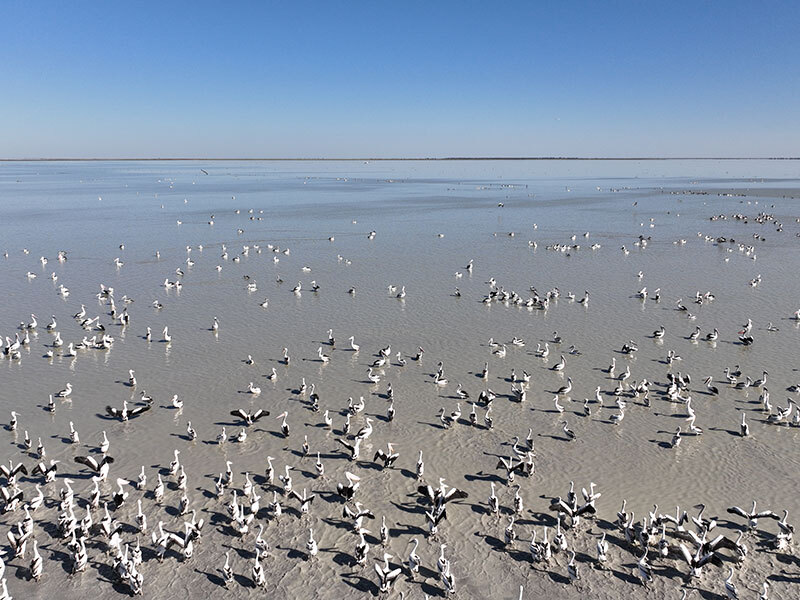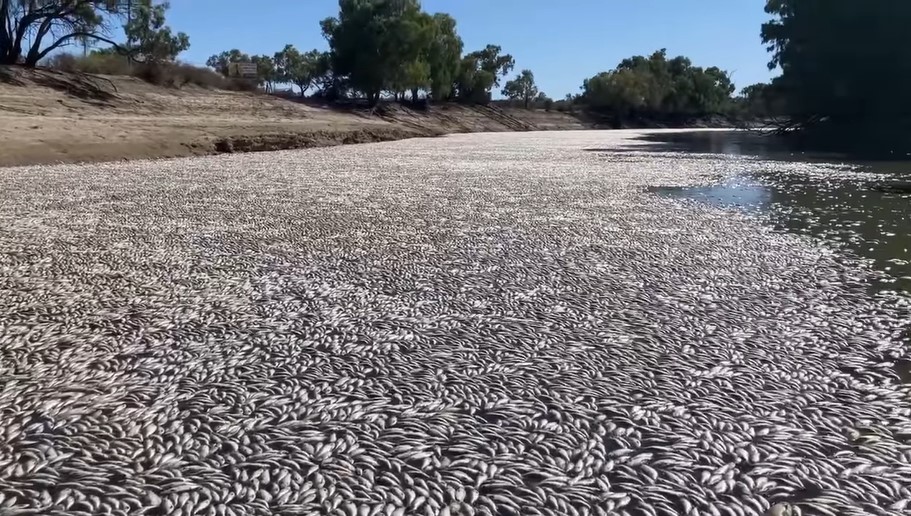Scientists suggest ways to continue the Narran Lake pelican success story
Kristin Murdock
11 September 2023, 9:20 PM
 Pelicans were banded at Narran Lakes earlier this year, due to an influx of breeding birds, not seen for many years.
Pelicans were banded at Narran Lakes earlier this year, due to an influx of breeding birds, not seen for many years.A group of scientists - the Wentworth Group of Concerned Scientists (WGCS) - have weighed in on the ongoing Murray-Darling Basin Plan (MDBP) debate.
WGCS are an independent group of scientists and professionals, working to secure the long-term health of Australia’s land, water and biodiversity. Professor Tim Flannery, one of Australia's leading writers on climate change is an influential scientist who is part of this group.
In a recently published research paper, WGCS found that the bare minimum flow requirements thought to be needed to keep key environments alive are not being met across much of the Murray Darling basin — and the situation has worsened since the $13 billion MDBP was introduced.
The Wentworth Group evaluated environmental water requirements against actual river flows measured at stream gauges in rivers, assessing the achievement of 72 science-based environmental flow requirements at 23 strategically located stream gauges spread across the Basin over a period of 43 years from 1979 to 2022.
WGCS reported that less than a third (31%) of the Basin’s environmental water requirements assessed were achieved in the past 43 years.
They found only about a quarter (26%) of all environmental flow requirements assessed were achieved in the decade since the Basin Plan 2012 was enacted.
A more detailed examination of results over the decades showed a declining trend with respect to achievement of environmental water requirements at most locations. Only two of the eight Ramsar wetlands of International Importance (Gwydir Wetlands, Narran Lake) received the overbank flows required to stay healthy.
This may explain why, earlier this year, pelicans returned to Narran Lakes to breed for the first time in many years. For the first time, Narran Lakes was added as a location where pelicans were banded by UNSW for research purposes.

Pelicans at Dharriwaa (Narran Lakes). PHOTO: Shot by Harro, UNSW.
UNSW Sydney Centre for Ecosystem Science, Senior Research Fellow, Dr Kate Brandis said, of particular interest were juvenile pelicans and finding out where they travel once they fledge. This helps in understanding which wetlands they use, to help better manage the species and wetlands.
“In the case of the Narran Lake colony, until this year pelicans had not bred at the Lake since the 1990s as there had not been sufficient flooding to support them for the six months needed to successfully raise chicks," Dr Brandis said. “If we find pelicans do return to their hatching place to breed, maintaining suitable habitat at Narran Lake for this cohort to return to in a few years’ time is essential to helping support Australian Pelicans into the future."
In contrast, the Lower Darling was subject to tragic fish death events in December 2018 and January 2019.

Dead fish in the Darling Baaka near Menindee. PHOTO: CSIRO
The large fish death events covered a 40 kilometre stretch of the Darling River, downstream of Menindee Lakes. Between December 2018 and January 2019 there were three mass fish deaths in the Lower Darling. At the time, researchers claimed that these deaths may have been contributed to by an alleged failed strategy to release a combination of “blackwater” and clean water by authorities.
WGCS members say both situations are examples of how governments' management of water in the Murray-Darling Basin can shape the ecosystem.
The 23 sites they examined already have detailed plans of how much water is required, and when, to be considered sustainable. Those plans — known as Environmental Water Requirements (EWR) — form part of the Murray-Darling Basin Plan, and are created by state governments based on the best available science.
WGCS say that if we are to reverse the current trajectory of decline around river flows, we need to ensure that the Basin Plan secures the minimum flow volumes needed, at the right place and the right time, to protect the health of the river and its people. They have outlined recommendations, including delivering outstanding components of the Basin Plan, linking flow requirements to water management decisions and ensuring a transparent, scientifically robust evidence base for implementing flow requirements.
WGCS warn that without sufficient flows, "there are serious and irreversible consequences for the long-term ecological health of the Basin, the quality of water, and the wellbeing of communities who depend on healthy rivers, including the 40 Aboriginal Nations that call the Basin home."




